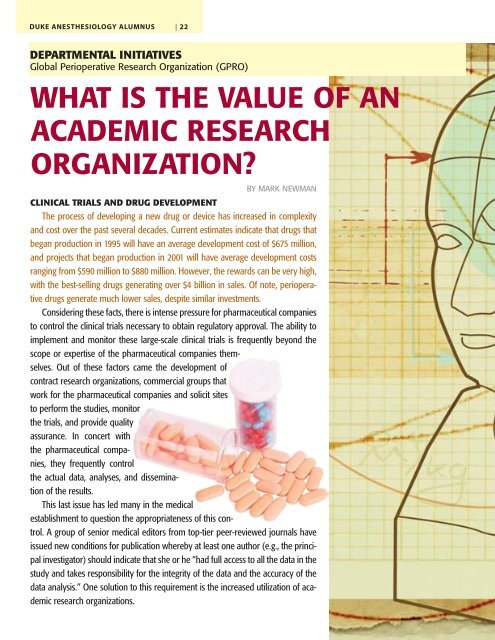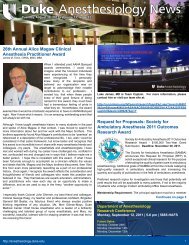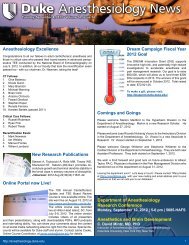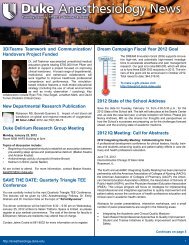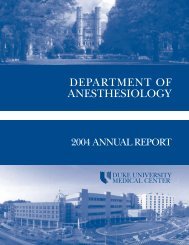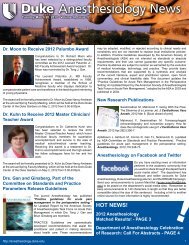04 wint anes alum single pgs - Department of Anesthesiology - Duke ...
04 wint anes alum single pgs - Department of Anesthesiology - Duke ...
04 wint anes alum single pgs - Department of Anesthesiology - Duke ...
Create successful ePaper yourself
Turn your PDF publications into a flip-book with our unique Google optimized e-Paper software.
DUKE ANESTHESIOLOGY ALUMNUS | 22<br />
DEPARTMENTAL INITIATIVES<br />
Global Perioperative Research Organization (GPRO)<br />
WHAT IS THE VALUE OF AN<br />
ACADEMIC RESEARCH<br />
ORGANIZATION?<br />
BY MARK NEWMAN<br />
CLINICAL TRIALS AND DRUG DEVELOPMENT<br />
The process <strong>of</strong> developing a new drug or device has increased in complexity<br />
and cost over the past several decades. Current estimates indicate that drugs that<br />
began production in 1995 will have an average development cost <strong>of</strong> $675 million,<br />
and projects that began production in 2001 will have average development costs<br />
ranging from $590 million to $880 million. However, the rewards can be very high,<br />
with the best-selling drugs generating over $4 billion in sales. Of note, perioperative<br />
drugs generate much lower sales, despite similar investments.<br />
Considering these facts, there is intense pressure for pharmaceutical companies<br />
to control the clinical trials necessary to obtain regulatory approval. The ability to<br />
implement and monitor these large-scale clinical trials is frequently beyond the<br />
scope or expertise <strong>of</strong> the pharmaceutical companies themselves.<br />
Out <strong>of</strong> these factors came the development <strong>of</strong><br />
contract research organizations, commercial groups that<br />
work for the pharmaceutical companies and solicit sites<br />
to perform the studies, monitor<br />
the trials, and provide quality<br />
assurance. In concert with<br />
the pharmaceutical companies,<br />
they frequently control<br />
the actual data, analyses, and dissemination<br />
<strong>of</strong> the results.<br />
This last issue has led many in the medical<br />
establishment to question the appropriateness <strong>of</strong> this control.<br />
A group <strong>of</strong> senior medical editors from top-tier peer-reviewed journals have<br />
issued new conditions for publication whereby at least one author (e.g., the principal<br />
investigator) should indicate that she or he “had full access to all the data in the<br />
study and takes responsibility for the integrity <strong>of</strong> the data and the accuracy <strong>of</strong> the<br />
data analysis.” One solution to this requirement is the increased utilization <strong>of</strong> academic<br />
research organizations.


